The Gear That Helped Me Turn My 4Runner into an Overlanding Rig
This article originally appeared on Outside
I'm not a convertible-sports-car kind of guy, so when I started feeling the pull of a midlife crisis, I did what some adventurous 44-year-old husbands and fathers would do: I fell deep into the rabbit hole of overlanding. You might be familiar with overlanding, in which people turn their trucks or SUVs into self-contained adventure vehicles capable of handling rough terrain and multiple nights in the backcountry. The niche has grown steadily over the last decade but became a full-blown movement in the past few years.
Fortunately, my old Toyota 4Runner is going through a midlife crisis at the exact same time I am. It's a 2000 third generation with 211,000 miles, and it has plenty of wear from various adventures and my two kids smashing Goldfish into the seat cushions. But my mechanic says the 4Runner is rock solid and, like me, is just hitting its life's halfway mark. What better way to give my trusty vehicle new life than to turn it into a bona fide miniature RV?
It's easy to get carried away when you start making upgrades to your vehicle--and overlanding is not an inexpensive hobby--so it's important to remember you don't need everything I'm listing to have a worthwhile experience. You can make do with a standard car-camping tent, a cooler, and some decent off-road tires. A lot of people go full-bore into the off-road aspect of the sport, beefing up the suspension and recovery equipment, but I'm not going to take the 4Runner rock hopping. I don't need to add a snorkel. It's a perfectly capable off-road vehicle straight off the assembly line. It's handled Utah's desert, Colorado's snow, and the southern Appalachians' combo of rock and mud without a single upgrade. I drive mostly on gravel and mellow dirt roads, on snow in the winter, and a bit of beach in the summer. My main goal isn't to drive to Patagonia without using a single highway but to take my family camping more often. I wanted to retrofit my rig so I can decide to go camping and be on the road in 15 minutes. Also, a third-generation 4Runner is tiny compared to the current model, so space is tight. Going into the project, I knew I had to be careful with the choices I made to maximize space.
But most important, it's been fun as hell. My 4Runner has a new life and I have a new hobby, which is basically the healthiest outcome you could expect from a midlife crisis. So here's the gear I've used to turn my old 4Runner into an overland machine.
Front Runner Roof Top Tent ($1,169)
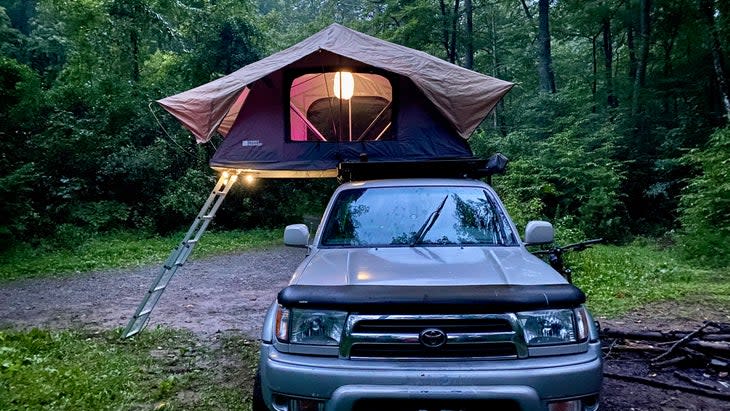
I debated long and hard about whether I needed a rooftop tent (RTT), but it finally came down to my original goal to make camping as easy as possible. Having the tent on my truck with a built-in mattress eliminates a lot of the hassle of camping. Front Runner is a South African company that tests its gear in the African bush in situations that are far more severe than any I'd experience. I like the company's pedigree, but this tent won me over because of its weight (just 95 pounds) and price, which is significantly less than most of the competition. But it still ain't cheap, and dropping $1,169 on a two-person tent can be hard to justify. For me, it was a matter of convenience, comfort, and getting off the ground. In the warmer months, it rains almost daily here in the Southern Appalachians, where I live. If it doesn't rain, a heavy dew settles in the middle of the night, which always makes the forest floor--and thus the bottom of my tent--wet. The RTT solves this problem because the rain fly typically dries in the morning and the floor doesn't get soggy. No more setting up a tent in the driveway when we get home. Also, the majority of my camping takes place at dispersed, primitive roadside sites that aren't improved and don't have a lot of flat, even ground. With the RTT, I always have a flat, smooth floor.
But when it comes down to it, the RTT is mostly about convenience. Setting it up is ridiculously easy: just unzip the waterproof case, pull down the ladder, and the tent unfolds accordion style. Add a handful of short poles for the rain fly, and it's good to go. It takes about five minutes. I've used it on countless occasions over the last several months and the process gets easier every time. I can even set it up and take it down in the dark without a headlamp. The 2.25-inch-thick high-density foam mattress is more comfortable than my bed at home and the built-in rain fly, made from waterproof 400-denier poly-oxford, sheds rain like an umbrella. It fits two adults with extra room, or one adult and two kids, and has plenty of panels that unzip to mesh, pockets for gear, and toggles to hang lights.
Beyond the price, there are some downsides of the RTT. I haven't noticed a big impact on my gas mileage, but it does limit how I can use the roof rack. I can't carry boats or bikes up there, which can be a real limitation. The biggest issue though, is that it forces you to stay in camp once you've set it up. Erect the tent and you're no longer mobile, which eliminates the ability to pitch a tent and then head into town for supplies. But overall, put me firmly in the pro-RTT category.
Front Runner Slimline II Rack ($795-$1,200)

This rack is the backbone of my overland system and the one upgrade that has turned my 4Runner into a camper. It's full-size and made of powder-coated T6 aluminum that runs the length of my roof. The Slimline is the foundation for my tent, although you might be able to mount a tent directly to your current rack. But the Slimline II is the smartest investment I made because it extends the car's carrying capacity. It holds my awning, anchors one side of a hammock, and has enough space in front of the tent for duffel bags, inflatable paddleboards, storage boxes, firewood--anything I can't fit inside the 4Runner. The low profile and built-in wind fairing at the front of the rack keep the noise to a minimum, even when I have the sunroof open. The tent occupies the majority of the rack, but if I wanted to remove it, I could add attachments for any kind of gear, from bikes to SUPs. Even with the tent on top, there are plenty of attachment options for me to shop for, like an ax carrier, a water-tank mounting system, a shower arm, etc. One thing to keep in mind, though, is that you want to keep the weight on your rack down, especially if you're getting into rough terrain, because top-heavy rigs are prone to rolling. Front Runner makes rack kits for a variety of car models, but because my 4Runner is borderline antique, I had to have a custom installation done at a local shop. If you have a newer SUV, you might be able to install the Slimline yourself.
Goal Zero Yeti 500X ($700)
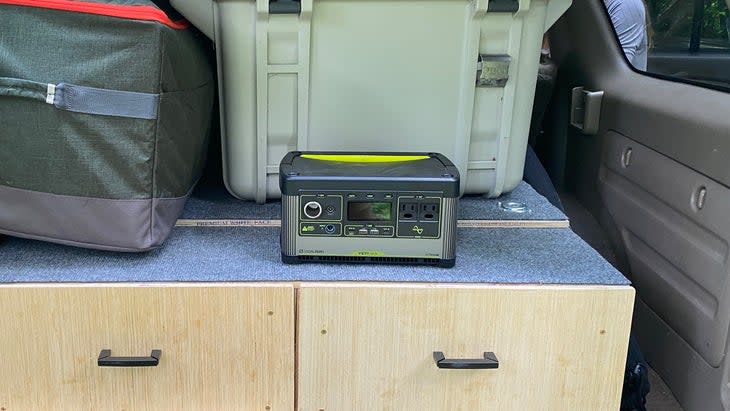
Now let's talk about when it's OK to go overboard. The Goal Zero Yeti 500X has way more power than I'll ever actually need during a weekend of camping, but for me, it's always better to have more than enough. I want to be able to power my lights, charge all my devices, and blow up every air mattress for all other campers within a 30-mile radius. This power bank can do that and more. It holds a battery capacity of 505 watt-hours--which is significant--but its plethora of output ports is what's most impressive. The 500X has almost every kind of port you need, including a 12-volt car port, a standard USB, an 18-watt USBC port for tablets, and a 60-watt USBC port specifically for laptops. It can power just about anything as long as it doesn't exceed the Goal Zero's 300-watt limit. The best part: it's tiny--roughly 20 percent smaller and 3.4 pounds lighter than the older Goal Zero Yeti 400. I charge it at home and get a full weekend of use with plenty of room to spare, but I could add solar panels to the top of the 4Runner and be completely self-sufficient for a longer trip. I also like the LCD display, which shows how much power I'm using and how much battery I have left. I've heard some users have had an issue with the battery not charging to 100 percent, but I haven't experienced it after several months of use. It does drain if it's stored unplugged, which is annoying but fairly common for lithium-ion technology. If the price is too steep, look at the Goal Zero Yeti 200X with 187 watt-hours of juice for $300.
DIY Drawer System and Sleeping Platform (roughly $300)
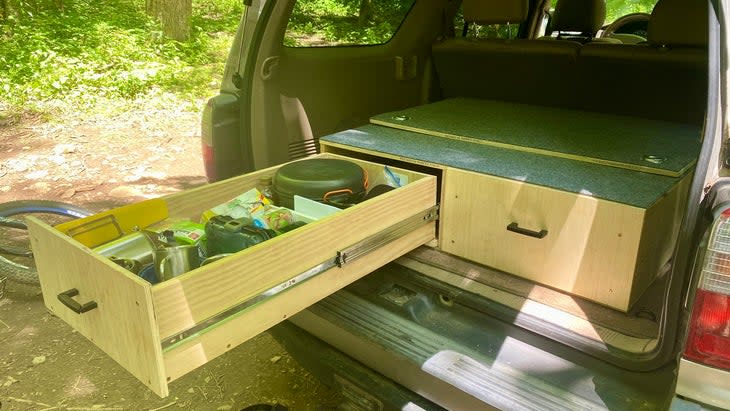
I don't care what those ultralight minimalists tell you. Car camping requires a lot of stuff and a place to put it all, which is why so many overlanders have some sort of drawer storage system. You can buy manufactured drawers that fit in the trunk of your SUV, but to save some money and give your vehicle a signature element, maybe flex a little creativity. I built a box with two drawers on sliders, each 34 inches long and 18 inches wide, that fits snugly between the 4Runner's wheel wells. That's enough room to hold all of my kitchen gear, lights, chairs, and everything else. I now have more drawer storage in my vehicle than I do in my kitchen, and there's no more "Did you forget the spatula?" because the spatula is in the car waiting for me to go camping. I've used the plastic-bin method in the past, but the drawers actually take up less room and give me a flat surface to pack on top of. I also built a sleeping platform that rests on top of the drawers. I used screw-on table legs to provide the foundation for a flat space big enough for two very friendly people to sleep on with the back seats down. The sleeping platform allows my whole family to sleep in or on top of the car without pitching a tent. I covered the whole thing in cheap carpet that I'm sure will get ruined before the end of the year, but I might re-cover it with yoga mats in the future. The system anchors to the 4Runner via D-rings so I didn't have to drill into the bed of the vehicle, and I can remove it easily if I need to. Whether you build something yourself or purchase one from a manufacturer, I'd argue that having this drawer system is more valuable than a rooftop tent because of the space-saving organization it affords. Now I can get out the door fast, without having to look for my headlamp, because I know everything is already in the 4Runner.
Otterbox Venture Cooler ($300)

Most overlanders are gaga over plug-in fridges like the models Dometic makes, and I get it--melted ice sucks. But the majority of my excursions fit into a weekend, well within the capabilities of a decent cooler. Ultimately, though, choosing a cooler over a fridge came down to cost. If I get deeper into overlanding and find myself living off the grid for a week or more at a time, I'll revisit that decision.
I have more than my fair share of beefy, expensive coolers sitting in my garage, but the Venture is the one that consistently gets put in the back of the rig for camping trips. I'm not saying it's the best rotomolded cooler out there--other options have better ice retention--but the Venture makes up for it with its portability. Yes, it can keep ice for a full weekend in the hot South without having to refill, and it's big enough to hold all the beer and food we need. But it's relatively light (26 pounds empty) and shaped more like a cube than a long rectangle, so it's easier to pick up solo and doesn't occupy the entire trunk of the 4Runner. I also really like the internal organization--you can add a divider (not included) and a dry storage tray to keep certain items cold but not wet. You can also buy a detachable side table and cup holders, which turn the cooler into a usable piece of furniture.
SureCall Fusion 2Go Max ($500)
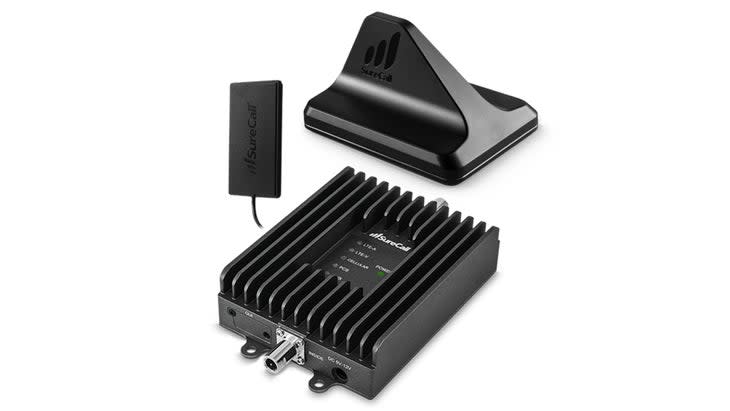
I understand that a lot of people go camping to get away from the grind, but sometimes staying connected is necessary. SureCall uses two antennae, one inside and one outside the car, to boost the signal from nearby cell towers. This gives you better service while also improving the data speed for LTE internet. It doesn't actually create a signal--it needs some sort of signal to boost, so if you're in a complete dead zone, it won't do you any good. And it took me a while to find the right spot for the external antenna. But once I got the system dialed in, I saw significant improvement of my cell service in the national forest. I also like that it uses a dBm test that breaks down the strength of your signal into a numerical value rather than the four vague bars you usually see. To do this test on an iPhone, follow this link. I spent a few months testing it all over my usual haunts, and I found my service to be consistently more reliable in places where it had been spotty before. I was able to send texts and calls deeper in Pisgah National Forest and even used my phone as a Wi-Fi hot spot to do internet research and send emails in places where I'd normally be lucky to get a text out. It's not cheap, but if staying connected is important and you like to work from the woods, it's a splurge that could pay for itself.
Yakima HangOver ($749)

We take our mountain bikes with us everywhere because my son has discovered a love for building jumps, then sessioning said jumps, until we make him stop. Having the tent on top of the 4Runner means we need to carry our bikes with the hitch, and after years of trial and error, I've decided the HangOver, which uses the vertical shuttle-bus configuration, is the best rack for carrying four bikes. It's heavy (65 pounds) and cumbersome to carry, so I tend to leave it on the vehicle at all times. The rack hinges away from the car to give full access to the trunk, even while it's carrying four bikes. And loading it is a breeze--much easier than the old-school hitch racks with the two arms that support the bikes' frames. I've found that the bikes take up less space when they're stored vertically, so it's easy to drive and park with them loaded. The only limitation I've found over the last year is that it can't carry road bikes; the mounts are specifically designed to handle the suspension forks of mountain bikes.
Primus CampFire Table ($130)

You can never have too much table space when you're camping with a family of four, so I've added the CampFire to my kit. It packs down into a long, flat package, so it's easy to store over the wheel-well beside my drawers, and it snaps back together in seconds. The tabletop is wrapped in poly-cotton, but unlike the coverings of many ultralight fabric-top tables (it weighs 3.75 pounds), the CampFire's fabric hides three broad slats of aluminum that unfold into a surface sturdy enough to handle heavy use--like cooking dinner or hosting game night. It's also big enough (basically two feet by two feet) to accommodate the whole family at dinner. I'll even use this table as a desk when I'm working at the trailhead. The CampFire has quickly become an indispensable part of my overlanding kit and basically lives in the back at all times.
Primus ETA Lite+ and French Press ($115)

Coffee is priority number one in the morning, so I keep this tiny system in my drawers so I can brew quickly after stumbling out of bed. The ETA Lite+ comprises a 17-ounce pot/mug and a 4500 BTU burner that clicks firmly into place below the pot so they become one unit. It can boil water for two cups of coffee in under three minutes and, maybe more important, it's self-contained and doesn't take up too much space in my drawers.
Jetboil Genesis ($270)
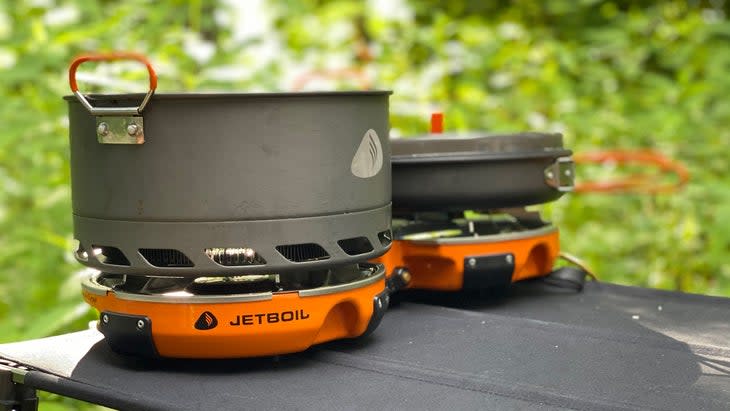
I have nothing against traditional two-burner stoves (I love my Camp Chef Rainier), but space is at a premium in my rig, so the Genesis has become my go-to cooking system. The two burners fold into each other and then nest inside a large pot and skillet (with a lid). It provides pro-grade cooking power (10,000 BTUs per burner) but takes up minimal room in my drawers. I've always been a fan of Jetboil's individual stoves, but the Genesis is my favorite of its lineup. It never fails to light, has enough power to cook a massive dinner for the whole family, and is compatible with the ubiquitous green Coleman propane canisters, which means it works with reusable tanks like the Ignik too.
Midland MXT275 MicroMobileRadio ($165)

I originally thought I wanted a citizen's-band radio (CB) because it's been the standard means of communication in 18-wheelers, RVs, and overland vehicles for decades. The systems are relatively inexpensive and allow for direct communication. But then I dissected exactly how I wanted to communicate when I'm off the grid. Nobody else I camp with has a CB, and most of the time I just want to be able to get a hold of my kids when they're in the woods away from camp. So I went with a GMRS two-way radio, essentially a more powerful version of the walkie-talkie that installs in the cockpit of the car and communicates both on the GMRS system and with standard handheld radios. It has a five-to-ten-mile range in the worst conditions (think city skyscrapers) and a 15-mile range in your typical forest. I can give my kids a handheld, send them off into the woods, and call them back when I have dinner ready. Or I can lend a couple of handhelds to the other campers in our group so we can stay in touch while we're driving and don't have cell service. It also pulls in NOAA's Weather Radio station, so I can get real-time forecasts, which play on an updating loop 24/7 no matter where I am. The license to operate it costs $70, but it lasts for ten years and covers your whole family.
For exclusive access to all of our fitness, gear, adventure, and travel stories, plus discounts on trips, events, and gear, sign up for Outside+ today.

